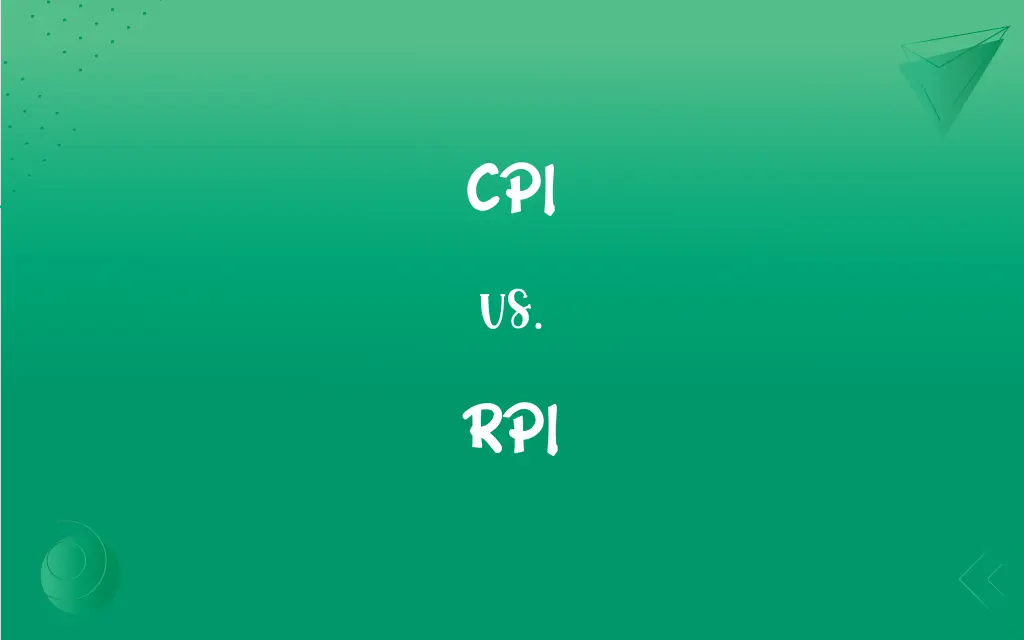CPI vs. RPI: What's the Difference?
Edited by Aimie Carlson || By Janet White || Published on March 2, 2024
CPI (Consumer Price Index) measures inflation using a basket of goods excluding housing costs, while RPI (Retail Price Index) includes mortgage interest payments.

Key Differences
CPI, or Consumer Price Index, is a measure of the average change over time in the prices paid by urban consumers for a market basket of consumer goods and services. RPI, or Retail Price Index, similarly measures the change in the cost of retail goods and services, including housing costs like mortgage interest payments, which CPI excludes. Both indexes are used to measure inflation but differ in their scope and the items they include.
The method of calculation for CPI involves a fixed basket of goods and services with the exclusion of certain costs such as mortgage interest payments, which are considered in RPI. This distinction makes CPI a narrower measure of inflation compared to RPI. While CPI is used widely for setting monetary policy, RPI finds its use in adjusting pensions, wages, and index-linked bonds, reflecting broader inflationary changes including housing costs.
Inflation rates reported by CPI are generally lower than those reported by RPI due to the exclusion of housing costs in CPI. This difference can significantly impact economic decisions and policies. For instance, governments and central banks may rely on CPI for policy-making due to its focus on the consumer sector excluding housing, while RPI's inclusion of housing costs makes it relevant for wage negotiations and pension adjustments.
The basket of goods and services used in CPI calculations is updated more frequently than RPI, reflecting changes in consumer spending patterns more accurately. RPI, on the other hand, has been criticized for its outdated calculation method, which can overestimate inflation. Despite this, RPI continues to be used for certain contracts and financial instruments due to its long history and comprehensive coverage of household expenses.
Both CPI and RPI provide valuable insights into the inflationary trends of an economy, yet their application depends on the specific requirements of policy-making, financial contracts, and economic analysis. The choice between CPI and RPI for a particular purpose involves considering the inclusion or exclusion of housing costs and the method of calculation, which can influence the perceived rate of inflation.
ADVERTISEMENT
Comparison Chart
Definition
Measures inflation excluding housing
Measures inflation including housing
Inclusion of Housing
Excludes mortgage interest payments
Includes mortgage interest payments
Usage
Monetary policy, inflation targeting
Wage adjustments, pensions
Calculation Method
Laspeyres formula
Carli and Dutot formulas
Coverage
Urban consumers
All households, including housing
ADVERTISEMENT
Frequency of Update
Basket updated frequently
Basket updated less frequently
Reported Inflation Rate
Generally lower
Generally higher
CPI and RPI Definitions
CPI
A tool used by policymakers to set interest rates and inflation targets.
Due to rising CPI, the government considered tightening monetary policy.
RPI
A measure of inflation that includes housing costs such as mortgage interest payments.
RPI figures were used to adjust my annual rail fare.
CPI
Used to adjust salaries, pensions, and benefits to maintain purchasing power.
Annual COLA increases are often pegged to CPI to protect against inflation.
RPI
Utilized in discussions between employers and employees to adjust wages according to inflation.
The union demanded wage increases in line with RPI.
CPI
A statistical estimate constructed using the prices of a sample of representative items whose prices are collected periodically.
The CPI increase led to adjustments in social security benefits.
RPI
Reflects the cost of living including housing expenses, providing a broad measure of inflation.
RPI is often higher than CPI due to the inclusion of housing costs.
CPI
An economic indicator that measures the rate of inflation in the economy by tracking changes in the cost of a fixed basket of goods.
Central banks closely monitor CPI to guide monetary policy.
RPI
Used to adjust pension payments to reflect the cost of living increases.
Pension payments this year were up due to an increase in RPI.
CPI
Init of characters per inch
RPI
A reference for adjusting payments in long-term contracts and leases.
Our lease agreement escalates rent annually based on RPI.
CPI
The measure of a number of typeset font characterss per inch used or supported by a digital display device
CPI
(computing) The measure of characters that can be stored in each inch of magnetic tape
CPI
The consumer price index, an index of the cost of all goods and services to a typical consumer. The increase of this value each year is one measure of monetary inflation.
CPI
An index of the cost of all goods and services to a typical consumer
CPI
A self-report personality inventory originally derived from the MMPI; consists of several hundred yes-no questions and yields scores on a number of scales including dominance and self acceptance and self control and socialization and achievement etc.
CPI
A measure used by economists to analyze inflation trends and economic health.
Analysts attributed the economic slowdown to a stagnant CPI.
FAQs
Why is CPI generally lower than RPI?
CPI excludes housing costs, which are included in RPI.
What is RPI?
RPI measures inflation including housing costs like mortgage interest payments.
What is CPI?
CPI measures inflation excluding housing costs.
How do RPI and CPI affect wage negotiations?
RPI is often used for wage adjustments due to its inclusion of housing costs.
How is RPI calculated?
RPI includes a broader range of goods and services, including housing costs.
How do pensions use CPI and RPI?
RPI is used for pension adjustments, reflecting broader cost of living changes.
How is CPI calculated?
CPI uses a basket of goods and services excluding housing, updated periodically.
Can CPI and RPI be used interchangeably?
No, due to differences in their coverage and calculation.
Which is more frequently updated, CPI or RPI?
CPI's basket of goods is updated more frequently than RPI's.
Why might one prefer RPI over CPI?
For a broader measure of inflation including housing.
Why is CPI preferred for monetary policy?
It focuses on consumer sector inflation excluding housing.
Is RPI still relevant?
Yes, for certain contracts and financial instruments.
How does CPI affect consumers?
It influences cost of living adjustments and purchasing power.
How does CPI relate to economic health?
It's an indicator of inflation trends and economic stability.
Why update the CPI basket of goods?
To accurately reflect current consumer spending patterns.
Which inflation measure is higher?
RPI typically reports higher inflation rates due to housing costs.
Can RPI affect mortgage rates?
Indirectly, as it reflects housing cost inflation.
Do CPI and RPI impact interest rates?
CPI is more directly used to guide interest rate decisions.
What makes RPI controversial?
Its calculation method can overestimate inflation.
Are CPI and RPI used globally?
While concepts are global, specific indices and names vary by country.
About Author
Written by
Janet WhiteJanet White has been an esteemed writer and blogger for Difference Wiki. Holding a Master's degree in Science and Medical Journalism from the prestigious Boston University, she has consistently demonstrated her expertise and passion for her field. When she's not immersed in her work, Janet relishes her time exercising, delving into a good book, and cherishing moments with friends and family.
Edited by
Aimie CarlsonAimie Carlson, holding a master's degree in English literature, is a fervent English language enthusiast. She lends her writing talents to Difference Wiki, a prominent website that specializes in comparisons, offering readers insightful analyses that both captivate and inform.































































